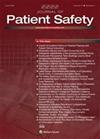"还能是什么?患者在整个诊断过程中应询问的问题范围综述》(A Scoping Review of Questions for Patients to Ask Throughout the Diagnostic Process.
IF 1.7
3区 医学
Q3 HEALTH CARE SCIENCES & SERVICES
引用次数: 0
摘要
背景诊断错误是一项全球性的患者安全挑战。在门诊护理中,75% 以上的诊断错误是由于患者与医生之间的沟通不畅造成的。鼓励患者大胆发言并提出问题已被推荐为减少这些失误的策略之一。目标范围审查的目的是识别、总结并按主题绘制建议患者在门诊就医过程中沿着诊断流程提出的问题。这是一项大型研究的第一步,该研究旨在共同设计一个面向患者的问题提示列表,供患者在整个诊断过程中使用。方法搜索了 Medline 和 Google Scholar,以确定同行评议文献中的问题列表。搜索机构网站和搜索引擎,以确定灰色文献中的问题列表。筛选符合条件的文章和资源,并摘录数据。结果共有来自 235 个资源的 5509 个问题符合纳入标准。大多数问题(n = 4243,77.02%)是在灰色文献中发现的。问题列表平均包含 23.44 个问题。尽管建议患者提问,但大多数问题提示列表都集中在诊断过程的后期阶段,如诊断沟通、治疗和结果。需要进一步开展研究,从患者的角度识别诊断相关问题并确定其优先顺序,同时制定简单、可用的提问指南,以改善整个诊断过程中的患者安全。本文章由计算机程序翻译,如有差异,请以英文原文为准。
"What Else Could It Be?" A Scoping Review of Questions for Patients to Ask Throughout the Diagnostic Process.
BACKGROUND
Diagnostic errors are a global patient safety challenge. Over 75% of diagnostic errors in ambulatory care result from breakdowns in patient-clinician communication. Encouraging patients to speak up and ask questions has been recommended as one strategy to mitigate these failures.
OBJECTIVES
The goal of the scoping review was to identify, summarize, and thematically map questions patients are recommended to ask during ambulatory encounters along the diagnostic process. This is the first step in a larger study to co-design a patient-facing question prompt list for patients to use throughout the diagnostic process.
METHODS
Medline and Google Scholar were searched to identify question lists in the peer-reviewed literature. Organizational websites and a search engine were searched to identify question lists in the gray literature. Articles and resources were screened for eligibility and data were abstracted. Interrater reliability (K = 0.875) was achieved.
RESULTS
A total of 5509 questions from 235 resources met inclusion criteria. Most questions (n = 4243, 77.02%) were found in the gray literature. Question lists included an average of 23.44 questions. Questions were most commonly coded along the diagnostic process categories of treatment (2434 questions from 250 resources), communication of the diagnosis (1160 questions, 204 resources), and outcomes (766 questions, 172 resources).
CONCLUSIONS
Despite recommendations for patients to ask questions, most question prompt lists focus on later stages of the diagnostic process such as communication of the diagnosis, treatment, and outcomes. Further research is needed to identify and prioritize diagnostic-related questions from the patient perspective and to develop simple, usable guidance on question-asking to improve patient safety across the diagnostic continuum.
求助全文
通过发布文献求助,成功后即可免费获取论文全文。
去求助
来源期刊

Journal of Patient Safety
HEALTH CARE SCIENCES & SERVICES-
CiteScore
4.60
自引率
13.60%
发文量
302
期刊介绍:
Journal of Patient Safety (ISSN 1549-8417; online ISSN 1549-8425) is dedicated to presenting research advances and field applications in every area of patient safety. While Journal of Patient Safety has a research emphasis, it also publishes articles describing near-miss opportunities, system modifications that are barriers to error, and the impact of regulatory changes on healthcare delivery. This mix of research and real-world findings makes Journal of Patient Safety a valuable resource across the breadth of health professions and from bench to bedside.
 求助内容:
求助内容: 应助结果提醒方式:
应助结果提醒方式:


